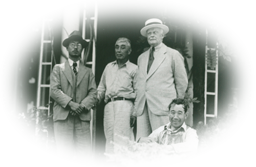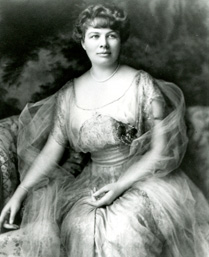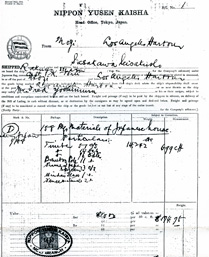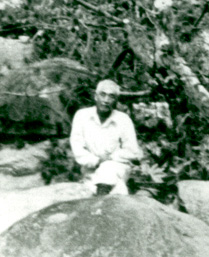Charles & Ellamae Storrier Stearns
Their Lives. Their Travels. Their Union.
Charles Storrier Stearns and Ellamae Sheppard were married in 1931 and started their life together in one of the grand homes that proliferated in the South Orange Grove area of Pasadena at that time. Theirs was a three-story Georgian mansion built in the early 1900s. It was situated on an estate covering over seven city lots, extending almost an entire block on Arlington Drive between Orange Grove Avenue and Pasadena Avenue. Charles was 61 years old and Ellamae was fifty-nine. It was his second marriage and her third.
Charles was born in Hartford, Connecticut in 1868. His father was a distinguished physician of some renown, with a number of published works on the treatment of the insane. His portrait hangs at Yale University. In 1917 Charles took up residence in France, with homes in both Nice and Paris. When he renewed his passport in 1922 he described himself as a retired capitalist. In 1928 he was knighted by the French government in recognition of his humanitarian work helping refugees of the Russian Revolution. A few years later, in June 1931, articles in major newspapers, including the Los Angeles Times, and the New York Times reported that he was decorated with the Order of Legion of Honor at a ceremony conducted at the Louvre in recognition of gifts of art works to French museums.
Less is known of Ellamae than Charles. She was born in 1872 in San Francisco, Ellamae Goodale, and was described by her great nephew as ravishingly beautiful when she was young. She lived in Hawaii during her first marriage to a Dr. Camp, which ended in divorce after three years. In 1913 she married for a second time in London, England to William B. Sheppard. She was 41 years old. In 1920 they were living in Bryn Mawr, Pennsylvania and were listed in the Philadelphia Social Register. The marriage lasted until Sheppard’s death sometime in the 1920s.
Ellamae, like Charles made a number of ocean crossings, both to Europe and the Orient, and like Charles she held dual passports, for the U.S. and France. It appears likely that they met either in France or on shipboard during one of their many ocean voyages. Until 1930 Charles was always accompanied on his travels by his first wife, Marian Weed Stearns. But on the November, 1930 passenger list for the Statendam traveling from Boulogne Sur Mer, France to New York, Charles was traveling alone as a single male (by this time Marion Weed had died though the date is uncertain). The next year, he and Ellamae were married.
Charles died in 1944 and Ellamae five years later, with no children or any known heirs.California
Japanese-Style Gardens

In the 1930s Ellamae and Charles made several trips to Japan which probably served as an inspiration to create the Japanese-style garden at their Pasadena home.
About this time, according to Judy M. Horton, Pacific Horticulture Fall 2007, many of the great estates installed Japanese gardens. Some were small tea gardens, consisting of a Japanese teahouse, often authentic, set in a naturalistic landscape; others were opulent creations featuring large ponds crossed by bridges.The Depression put an end to grand estates, and the vogue for Japanese gardens cooled in the late thirties as American relations with the Japanese government became strained. Shortly after the 1941 attack on Pearl Harbor, all persons of Japanese ancestry in the western United States were sent to internment camps for the duration of the war.
Entwined with the history of Japanese-style gardens is the social and labor history of these immigrants. A paradox of Japanese-style garden making is that it flourished in the early twentieth century at a time when Japanese immigrants were faced with racial prejudice and legal discrimination, barred from becoming citizens and, in California, owning land. Garden making became one of the few occupations open to them.
Modern HistoryKinzuchi Fujii
A Design Legacy
His Life. His Internment.
In 1935 Charles and Ellamae hired Kinzuchi Fujii to design and create their new garden. It was the one great commission of Kinzuchi Fujii’s life. Born in Japan in 1875, he emigrated to the U.S. in 1903 and although an enterprising and capable person with a background in carpentry and landscaping, he faced the barriers and discrimination that were the lot of immigrants from the Orient at that time.
By 1930 Kinzuchi was employed in building several small gardens in Ojai and Santa Barbara. On the basis of a letter seeking prospective clients, accompanied by impressive recommendations, he was hired by the Storrier Stearns’. Kinzuchi devoted the next seven years of his life to creating the garden. In 1942, shortly after the outbreak of World War II, he suffered the fate of other Japanese residents and was sent to an internment camp for the duration of the war. Kinzuchi considered the Storrier Stearns garden his masterpiece and carried the photographs and plans documenting the creation of the garden with him, in the single suitcase allowed by the government, into internment. Kinzuchi never saw his beloved creation again.
Kinzuchi’s Design Philosophy.
“Garden-making is much the same as all other branches of fine arts and the inner spirit is as much, and maybe more, important as the outward form.”
Fujii wrote: “I am possessed of an ambition to leave a real, uncompromising Japanese garden in the United States.” His wish was to create garden plans strictly Japanese in design and finish, guided by these design principles:- Cement lanterns & semi-circular wooden bridges were inevitable in Japanese-style gardens in the U.S. but deemed unnecessary in traditional Japanese garden design
- Expensive materials are not required in Japanese garden-making
- Common timber, rocks & shrubbery, found on the site, should be transformed into real assets by the true artist
- One should take in the natural surroundings as part of the garden design
- Perhaps merging the garden end with the distant undulating hills in the site’s background
- High mountains and great expanse(s) of water may be combined for similar visual effects



